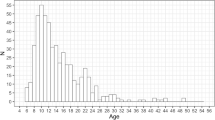Abstract
Recognizing emotional face expressions in others is a valuable non-verbal communication and particularly relevant throughout childhood given that children’s language skills are not yet fully developed, but the first interactions with peers have just started. This study aims to investigate developmental markers of emotional facial expression in children and the effect of age and sex on it. A total of 90 children split into three age groups: 6–7 years old (n = 30); 8–9 years old (n = 30); 10–11 years old (n = 30) took part in the study. Participants were exposed to 38 photos in two exposure times (500 ms and 1000 ms) of children expressing happiness, sadness, anger, disgust, fear and surprise on three intensities, plus images of neutral faces. Happiness was the easiest expression to be recognized, followed by disgust and surprise. As expected, 10–11-year-old group showed the highest accuracy means, whereas 6–7-year-old group had the lowest means of accuracy. Data support the non-existence of female advantage.


Similar content being viewed by others
Availability of data and material
Data that support the findings of this study are available on request to the corresponding author due to privacy/ethical restrictions.
References
Achenbach T, Dumenci L (2001) Advances in empirically based assessment: revised cross-informant syndromes and new DSM-oriented scales for the CBCL, YSR, and TRF: Comment on Lengua, Sadowksi, Friedrich, and Fisher (2001). J Consult Clin Psychol 69(4):699–702. https://doi.org/10.1037//0022-006X.69.4.699
Adolphs R (2002) Neural systems for recognizing emotion. Curr Opin Neurobiol 12(2):169–177. https://doi.org/10.1016/S0959-4388(02)00301-X
Angelini AL, Alves IC, Custódio EM, Duarte WF, Duarte JL (1999) Matrizes Progressivas Coloridas de Raven: Escala Especial. Centro Editor de Testes e Pesquisa em Psicologia, São Paulo
Bandeira DR, Alves ICB, Giacomel AE, Lorenzatto L (2004) Matrizes progressivas coloridas de Raven—escala especial: normas para Porto Alegre, RS. Psicol Estud [online] 9(3):479–486. https://doi.org/10.1590/s1413-73722004000300016
Batty M, Taylor MJ (2006) The development of emotional face processing during childhood. Dev Sci 9(2):207–220. https://doi.org/10.1111/j.1467-7687.2006.00480.x
Batty M, Meaux E, Wittemeyer K, Rogé B, Taylor MJ (2011) Early processing of emotional faces in children with autism: an event-related potential study. J Exp Child Psychol 109:430–444. https://doi.org/10.1016/j.jecp.2011.02.001
Bordin IA, Mari JJ, Caeiro MF (1995) Validação da versão brasileira do "Child Behavior Checklist" (CBCL) (Inventário de Comportamentos da Infância e Adolescência): dados preliminares. Revista ABP-APAL, 55–66. https://www.researchgate.net/profile/Isabel-Bordin/publication/285968522_Validation_of_the_Brazilian_version_of_the_Child_Behavior_Checklist_CBCL/links/59f8c278a6fdcc075ec99697/Validation-of-the-Brazilian-version-of-the-Child-Behavior-Checklist-CBCL.pdf
Calvo MG, Lundqvist D (2008) Facial expressions of emotion (KDEF): identification under different display-duration conditions. Behav Res Methods 40(1):109–115. https://doi.org/10.3758/BRM.40.1.109
Cassia V, Pisacane A, Gava L (2012) No own-age bias in 3-year-old children: more evidence for the role of early experience in building face-processing biases. J Exp Child Psychol 113(3):372–382. https://doi.org/10.1016/j.jecp.2012.06.014
Cheal JL, Rutherford MD (2011) Categorical perception of emotional facial expressions in preschoolers. J Exp Child Psychol 110(3):434–443. https://doi.org/10.1016/j.jecp.2011.03.007
Chen FS, Schmitz J, Domes G, Tuschen-Caffier B, Heinrichs M (2014) Effects of acute social stress on emotion processing in children. Psychoneuroendocrinology 40:91–95. https://doi.org/10.1016/j.psyneuen.2013.11.003
Dalrymple KA, Gomez J, Duchaine B (2013) The dartmouth database of children’s faces: acquisition and validation of a new face stimulus set. PLoS ONE 8(11):1–7. https://doi.org/10.1371/journal.pone.0079131
De Sonneville L, Verschoor C, Njiokiktjien C, Op het Veld V, Toorenaar N, Vranken M (2002) Facial identity and facial emotions: speed, accuracy, and processing strategies in children and adults. J Clin Exp Neuropsychol 24(2):200–213. https://doi.org/10.1076/jcen.24.2.200.989
Deeley Q, Daly EM, Azuma R et al (2008) Changes in male brain responses to emotional faces from adolescence to middle age. Neuroimage 40:389–397. https://doi.org/10.1016/j.neuroimage.2007.11.023
Dennis TA, Malone MM, Chen CC (2009) Emotional face processing and emotion regulation in children: an ERP study. Dev Neuropsychol 34(1):85–102. https://doi.org/10.1080/87565640802564887
Durand K, Gallay M, Seigneuric A, Robichon F, Baudouin J (2007) The development of facial emotion recognition: the role of configural information. J Exp Child Psychol 97(1):14–27. https://doi.org/10.1016/j.jecp.2006.12.001
Ebner NC, Johnson MR, Rieckmann A, Durbin KA, Johnson MK, Fischer H (2013) Processing own-age vs. other-age faces: neuro-behavioral correlates and effects of emotion. Neuroimage 78:363–371. https://doi.org/10.1016/j.neuroimage.2013.04.029
Ekman P, Friesen WV, O’Sullivan M, Chan A, Diacoyanni-Tarlatzis I, Heider K, Krause R, LeCompte WA, Pitcairn T, Ricci-Bitti PE, Scherer K, Tomita M, Tzavaras A (1987) Universals and cultural differences in the judgments of facial expressions of emotion. J Pers Soc Psychol 53(4):712–717. https://doi.org/10.1037/0022-3514.53.4.712
Ekman P, Friesen WV, Hager JC (2002) Facial action coding system: the manual on CD ROM. A Human Face, Salt Lake City
Ewing L, Karmiloff-Smith A, Farran EK, Smith ML (2017) Developmental changes in the critical information used for facial expression processing. Cognition 166:56–66. https://doi.org/10.1016/j.cognition.2017.05.017
Gagnon M, Gosselin P, Hudon-ven der Buhs I et al (2010) Children’s recognition and discrimination of fear and disgust facial expressions. J Nonverbal Behav 34:27–42. https://doi.org/10.1007/s10919-009-0076-z
Gao X, Maurer D (2009) Influence of intensity on children’s sensitivity to happy, sad, and fearful facial expressions. J Exp Child Psychol 102(4):503–521. https://doi.org/10.1016/j.jecp.2008.11.002
Gao X, Maurer D (2010) A happy story: Developmental changes in children’s sensitivity to facial expressions of varying intensities. J Exp Child Psychol 107(2):67–86. https://doi.org/10.1016/j.jecp.2010.05.003
Garcia SE, Tully EC (2020) Children’s recognition of happy, sad, and angry facial expressions across emotive intensities. J Exp Child Psychol 197:1–17. https://doi.org/10.1016/j.jecp.2020.104881
Halberstadt AG, Cooke AN, Garner PW, Hughes SA, Oertwig D, Neupert SD (2020) Racialized emotion recognition accuracy and anger bias of children’s faces. Emotion. https://doi.org/10.1037/emo0000756
Herba C, Phillips M (2004) Annotation Development of facial expression recognition from childhood to adolescence behavioural and neurological perspectives. J Child Psychol Psychiatry 45(7):1185–2119. https://doi.org/10.1111/j.1469-7610.2004.00316.x
Herba C, Landau S, Russell T, Ecker C, Phillips M (2006) The development of emotion-processing in children: effects of age, emotion, and intensity. J Child Psychol Psychiatry 47(11):1098–1106. https://doi.org/10.1111/j.1469-7610.2006.01652.x
Herba C, Benson P, Landau S et al (2008) Impact of familiarity upon children’s developing facial expression recognition. J Child Psychol Psychiatry 49(2):201–210. https://doi.org/10.1111/j-1469-7610.2007.01835.x
Hills PJ (2012) A developmental study of the own-age face recognition bias in children. Dev Psychol 48(2):499–508. https://doi.org/10.1037/a0026524
Kessels RPC, Montagne B, Hendriks AW, Perrett DI, Haan EHF (2013) Assessment of perception of morphed facial expressions using the emotion recognition task: normative data from healthy participants aged 8–75. J Neuropsychol 8(1):75–93. https://doi.org/10.1111/jnp.12009
Kommattam P, Jonas KJ, Fischer AH (2019) Perceived to feel less: Intensity bias in interethnic emotion perception. J Exp Soc Psychol 84:103809. https://doi.org/10.1016/j.jesp.2019.04.007
Lawrence K, Campbell R, Skuse D (2015) Age, gender, and puberty influence the development of facial emotion recognition. Front Psychol 6(761):1–14. https://doi.org/10.3389/fpsyg.2015.00761
Leime JL, Neto JR, Alves SM, Torro-Alves N (2013) Recognition of facial expressions in children, young adults and elderly people. Estud Psicol (campinas) 30(2):161–167. https://doi.org/10.1590/s0103-166x2013000200002
Mancini G, Agnoli S, Baldaro B, Bitti PE, Surcinelli P (2013) Facial expressions of emotions: recognition accuracy and affective reactions during late childhood. J Psychol 147(6):599–617. https://doi.org/10.1080/00223980.2012.727891
Marsh AA, Yu HH, Pine DS et al (2010) Oxytocin improves specific recognition of positive facial expressions. Psychopharmacology 209:225–232. https://doi.org/10.1007/s00213-010-1780-4
McClure E (2000) A meta-analytic review of sex differences in facial expression processing and their development in infants, children, and adolescents. Psychol Bull 126(3):424–453. https://doi.org/10.1037/0033-2909.126.3.424
Meinhardt-Injac B, Kurbel D, Meinhardt G (2020) The coupling between face and emotion recognition from early adolescence to young adulthood. Cogn Dev 53:1–10. https://doi.org/10.1016/j.cogdev.2020.100851
Naruse S, Hashimoto T, Mori K, Tsuda Y, Takahara M, Kagami S (2013) Developmental changes in facial expression recognition in Japanese school-age children. J Med Invest 60(1–2):114–120. https://doi.org/10.2152/jmi.60.114
Nikitin J, Freund AM (2019) The motivational power of the happy face. Brain Sci, 9(1), 6. MDPI AG. Retrieved from http://dx.doi.org/https://doi.org/10.3390/brainsci9010006
Poenitz V, Román F (2020) Trajectory of the recognition of basic emotions in the neurodevelopment of children and its evaluation through the “Recognition of Basic Emotions in Childhood” Test (REBEC). Front Edu 5:1–15. https://doi.org/10.3389/feduc.2020.00110
Pollak SD, Sinha P (2002) Effects of early experience on children’s recognition of facial displays of emotion. Dev Psychol 38(5):784–791. https://doi.org/10.1037/0012-1649.38.5.784
Pollak SD, Messner M, Kistler DJ, Cohn JF (2009) Development of perceptual expertise in emotion recognition. Cognition 110(2):242–247. https://doi.org/10.1016/j.cognition.2008.10.010
Rehnman J, Herlitz A (2007) Women remember more faces than men do. Acta Psychol (amst) 124(3):344–355. https://doi.org/10.1016/j.actpsy.2006.04.004
Rhodes MG, Anastasi JS (2012) The own-age bias in face recognition: a meta-analytic and theoretical review. Psychol Bull 138(1):146–174. https://doi.org/10.1037/a0025750
Richards A, French CC, Nash G, Hadwin JA, Donnelly N (2007) A comparison of selective attention and facial processing biases in typically developing children who are high and low in self-reported trait anxiety. Dev Psychopathol 19(2):481–495. https://doi.org/10.1017/S095457940707023X
Romani-Sponchiado A, Sanvicente-Vieira B, Mottin C, Hertzog-Fonini D, Arteche A (2015) Child Emotions Picture Set (CEPS): development of a database of children’s emotional expressions. Psychol Neurosci 8(4):467–478. https://doi.org/10.1037/h0101430
Scherf K, Scott L (2012) Connecting developmental trajectories: Biases in face processing from infancy to adulthood. Dev Psychobiol 54(6):643–663. https://doi.org/10.1002/dev.21013
Segal SC, Reyes BN, Gobin KC, Moulson MC (2019) Children’s recognition of emotion expressed by own-race versus other-race faces. J Exp Child Psychol 182:102–113. https://doi.org/10.1016/j.jecp.2019.01.009
Thomas LA, De Bellis MD, Graham R, LaBar KS (2007) Development of emotional facial recognition in late childhood and adolescence. Dev Sci 10(5):547–558. https://doi.org/10.1111/j.1467-7687.2007.00614.x
Vicari S, Reilly J, Pasqualetti P, Vizzotto A, Caltagirone C (2000) Recognition of facial expressions of emotions in school-age children: the intersection of perceptual and semantic categories. Acta Paediatr 89(7):836–845. https://doi.org/10.1080/080352500750043756
Widen S, Russell J (2008) Children acquire emotion categories gradually. Cogn Dev 23(2):291–312. https://doi.org/10.1016/j.cogdev.2008.01.002
Widen SC, Russell JA (2013) Children’s recognition of disgust in others. Psychol Bull 139:271–299. https://doi.org/10.1037/a0031640
Williams LM, Mathersul D, Palmer DM, Gur RC, Gur RE, Gordon E (2009) Explicit identification and implicit recognition of facial emotions: I. Age effects in males and females across 10 decades. J Clin Exp Neuropsychol 31(3):257–277. https://doi.org/10.1080/13803390802255635
Wright DB, Sladden B (2003) An own gender bias and the importance of hair in face recognition. Acta Psychol (amst) 114(1):101–114. https://doi.org/10.1016/s0001-6918(03)00052-0
Acknowledgements
The research reported was supported by the Coordenação de Aperfeiçoamento de Pessoal de Nível Superior (CAPES). The authors report no conflicts of interest.
Funding
The research reported was supported by the Coordenação de Aperfeiçoamento de Pessoal de Nível Superior (CAPES).
Author information
Authors and Affiliations
Contributions
All authors whose names appear on the submission made substantial contributions to the article. Contributions by author are detailed below according to CRediT taxonomy. Conceptualization: Aline Romani-Sponchiado, Adriane Xavier Arteche; Data curation: Aline Romani-Sponchiado, Cíntia Pacheco Maia, Carol Nunes Torres, Adriane Xavier Arteche; Formal analysis: Aline Romani-Sponchiado, Cíntia Pacheco Maia; Funding acquisition: Aline Romani-Sponchiado; Investigation: Aline Romani-Sponchiado, Cíntia Pacheco Maia, Carol Nunes Torres; Methodology: Aline Romani-Sponchiado, Adriane Xavier Arteche; Project administration: Aline Romani-Sponchiado, Adriane Xavier Arteche; Supervision: Carol Nunes Torres, Adriane Xavier Arteche; Resources: Aline Romani-Sponchiado, Carol Nunes Torres; Visualization: Aline Romani-Sponchiado, Cíntia Pacheco Maia, Carol Nunes Torres, Inajá Tavares; Writing – original draft: Aline Romani-Sponchiado, Cíntia Pacheco Maia, Carol Nunes Torres, Inajá Tavares, Adriane Xavier Arteche; Writing – review & editing: Aline Romani-Sponchiado, Cíntia Pacheco Maia, Carol Nunes Torres, Inajá Tavares, Adriane Xavier Arteche.
Corresponding author
Ethics declarations
Conflict of interest
The authors report no conflicts of interest.
Ethics approval
the questionnaire and methodology for this study was approved by the Human Research Ethics committee of the Pontifical Catholic University of Rio Grande do Sul (Ethics approval number: 26068114000005336).
Consent to participate
Informed consent was obtained from all legal guardians.
Additional information
Publisher's Note
Springer Nature remains neutral with regard to jurisdictional claims in published maps and institutional affiliations.
Editor: Massimiliano Palmiero (University of Bergamo); Reviewers: Giulia Prete (University of Chieti and Pescara) and a second researcher who prefers to remain anonymous.
Romani-Sponchiado and Maia are currently affiliated at Federal University of Rio Grande do Sul (UFRGS).
Supplementary Information
Below is the link to the electronic supplementary material.
Rights and permissions
About this article
Cite this article
Romani-Sponchiado, A., Maia, C.P., Torres, C.N. et al. Emotional face expressions recognition in childhood: developmental markers, age and sex effect. Cogn Process 23, 467–477 (2022). https://doi.org/10.1007/s10339-022-01086-1
Received:
Accepted:
Published:
Issue Date:
DOI: https://doi.org/10.1007/s10339-022-01086-1




